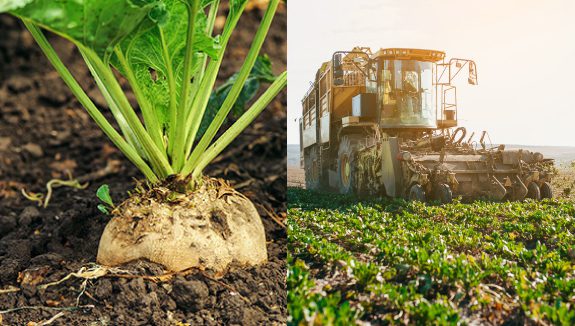Sugar beet vs sugar cane: Cost breakdown in the international sugar market
Revealing the Reality Behind Sugar Beet Vs Sugar Cane: Benefits, Makes Use Of, and Processing Techniques Explained
The distinction between sugar beet and sugar cane is frequently ignored in discussions concerning sugar production. Each plant presents unique advantages and applications in different markets. Their growing techniques and handling strategies additionally vary especially. Comprehending these subtleties is necessary for stakeholders in the sugar industry. What ramifications do these differences have for wellness, taste, and environmental influence? Discovering these elements can expose much deeper understandings right into the international sugar market.

Overview of Sugar Beet and Sugar Cane
Sugar beet and sugar cane are two primary sources of sugar, each with unique characteristics and cultivation methods. Sugar beet, an origin vegetable, flourishes in pleasant environments and is typically harvested in the fall. Its high sugar material, ranging from 15% to 20%, makes it a useful crop for sugar production. The process includes removing juice from the beetroots, which is then refined into granulated sugar.
In comparison, sugar cane is an exotic yard that thrives in warm, humid environments. It can accomplish a sugar content of as much as 14%, however its high, coarse stalks call for substantial handling. The cane is crushed to extract juice, which undertakes boiling and formation to create sugar. Both sources contribute significantly to the global sugar supply, with sugar beet mainly cultivated in Europe and North America, while sugar cane is chiefly grown in Brazil, India, and various other exotic areas.
Farming Practices: Sugar Beet vs. Sugar Cane
Growing techniques for sugar beet and sugar cane differ significantly because of their distinct expanding conditions. Sugar beets flourish in cooler climates with well-drained soil, while sugar cane favors warmer temperatures and plentiful moisture. Furthermore, the harvesting methods used for each and every crop mirror these ecological requirements and influence total return and top quality.
Expanding Problems Comparison
While both sugar beet and sugar cane thrive in specific environmental conditions, their cultivation techniques vary considerably. Sugar beet is primarily grown in temperate areas, favoring cooler environments with well-drained dirt and moderate rains. It calls for an expanding season of about 90 to 120 days, with perfect temperature levels between 15 ° C to 25 ° C. On the other hand, sugar cane embellishments in tropical and subtropical climates, prospering in warm temperature levels varying from 20 ° C to 32 ° C. It needs abundant sunshine and consistent rainfall, typically requiring watering in drier locations. Sugar cane has a much longer growing cycle, typically lasting 12 to 24 months. These distinctions in expanding problems significantly affect the geographical circulation and farming techniques connected with each crop.
Gathering Techniques Differences
The harvesting methods for sugar beet and sugar cane show their unique growth qualities and farming techniques. Sugar beet is normally collected mechanically, with harvesters made to uproot the whole plant, making sure minimal soil disturbance. The beetroots are then carried for processing soon after harvest to keep top quality. On the other hand, sugar cane harvesting often includes a combination of guidebook and mechanical techniques. Employees may at first reduce the cane by hand, especially in regions where automation is less feasible. Ultimately, specialized machinery is used to collect and transfer the cut stalks to processing centers. These differing methods not just influence effectiveness yet likewise influence the high quality and yield of the final sugar items, showcasing the adaptability of each crop to its atmosphere.
Nutritional Comparison and Wellness Conveniences
When contrasting the nutritional accounts of sugar beet and sugar cane, it comes to be clear that each offers distinctive health and wellness benefits. Sugar beets are abundant in essential nutrients like folate, manganese, and potassium, which add to total health and wellness. They additionally consist of fiber, which aids food digestion and might help control blood sugar level levels. In addition, sugar beetroots are recognized for their antioxidant residential properties, which can combat oxidative stress and anxiety.
On the other hand, sugar cane is mostly made up of sucrose, giving fast power. While it lacks the exact same degree of vitamins and minerals found in sugar beetroots, sugar cane does include percentages of B nutrients such as calcium and magnesium. Sugar cane juice is frequently proclaimed for its hydrating properties and potential health advantages, consisting of improved digestive system wellness. Ultimately, the selection in between sugar beet and sugar cane may depend on specific health and wellness objectives and dietary choices.
Flavor Accounts and Culinary Uses
Flavor profiles of sugar beet and sugar cane differ significantly, influencing their culinary applications (Sugar beet vs sugar cane). Sugar cane, with its naturally sweet and complicated taste, is commonly preferred in beverages, treats, and various culinary meals. It offers an abundant, caramel-like note that improves the preference of items such as syrups, molasses, and rum. In comparison, sugar beet has a more neutral and less aromatic preference, making it suitable for applications where sweetness is desired without altering the meal's intrinsic flavors. It is often made use of in refined foods, baked items, and sugar
Cooking experts More hints commonly select sugar cane for its depth and splendor, specifically in premium food preparation and craft drinks. Conversely, sugar beet's adaptability as a sugar in mass-produced products satisfies a wider market. Eventually, the choice between these 2 sugars can significantly influence taste accounts and overall culinary experiences.
Ecological Influence of Sugar Manufacturing
Sugar manufacturing, whether from sugar beet or sugar cane, carries considerable ecological implications. Sugar cane farming commonly brings about deforestation, especially in exotic areas, interrupting neighborhood environments and contributing to biodiversity loss. The substantial use plant foods and chemicals in both sugar beet and sugar cane farming can lead to dirt destruction and water air pollution, impacting bordering environments and areas. In addition, the high water intake needed for sugar cane watering poses a threat to local water supplies, especially in deserts.
Alternatively, sugar beet farming normally takes place in pleasant environments, which might his response minimize some logging problems. Nevertheless, it is not without its own obstacles, including soil erosion and dependence on chemical inputs. In general, the ecological effect of sugar manufacturing is complex, requiring lasting farming practices and awareness of resource monitoring to decrease damage to environments and advertise environmental wellness.
Processing Techniques: From Plant to Sugar
Various handling methods are utilized to transform sugar beet and sugar cane right into granulated sugar, each technique mirroring the one-of-a-kind attributes of the resource plant. For sugar beets, the process starts with washing and cutting the origins right into thin strips, which are after that subjected to diffusion-- a strategy where warm water extracts sugar from the beet slices. The resulting liquid is cleansed, concentrated, and crystallized.
In contrast, sugar cane processing involves squashing the stalks to draw out juice, adhered to by find out here now clarification to eliminate impurities. The juice is then vaporized, resulting in syrup that goes through crystallization. Both processes are complied with by separation of the sugar crystals from the molasses, which is a byproduct. The lasts include drying out and packaging the granulated sugar for distribution. These methods highlight the unique pathways where these 2 plants yield sugar, each with its very own collection of difficulties and effectiveness.
Financial Elements of Sugar Beet and Sugar Cane Industries
The financial landscape of the sugar beet and sugar cane industries reveals noteworthy distinctions in manufacturing costs, market dynamics, and regional influences. Sugar beet, largely expanded in temperate climates, commonly incurs greater manufacturing prices because of labor and input costs. Alternatively, sugar cane grows in exotic areas, typically taking advantage of reduced labor expenses and desirable climatic problems, which can result in higher yields.
Market dynamics also vary, as sugar cane controls international manufacturing, accounting for roughly 80% of sugar outcome. This occurrence influences rates structures and profession flows. In comparison, sugar beet is a lot more regionally focused, especially in Europe and North America, impacting local economies reliant on beet production.
In addition, changes in international sugar costs can substantially impact both industries, influencing farmer income and investment degrees. Understanding these financial facets is vital for stakeholders aiming to browse the intricacies of the sugar market properly.

Regularly Asked Inquiries

Can Sugar Beet and Sugar Cane Be Intercropped Efficiently?
Intercropping sugar beet and sugar cane provides challenges because of differing growth needs and environmental demands. With cautious administration and appropriate conditions, it may produce benefits such as enhanced dirt wellness and source performance.

What Are the Historical Beginnings of Sugar Beet and Sugar Cane?
The historic origins of sugar beet trace back to 18th century Europe, while sugar cane has roots in Southeast Asia, cultivated for hundreds of years. Both plants have considerably influenced worldwide sugar production and farming.
How Do Sugar Beet and Sugar Cane Affect Dirt Health?
The results of sugar beet and sugar cane on dirt health differ. Sugar beet can boost soil structure and nutrient web content, while sugar cane might diminish nutrients otherwise taken care of properly, influencing long-term dirt fertility.
Exist Any Arising Technologies in Sugar Manufacturing?
Emerging technologies in sugar manufacturing consist of accuracy agriculture, advanced hereditary engineering for higher yields, and cutting-edge removal approaches. These improvements aim to enhance performance, minimize ecological influence, and improve the total sustainability of sugar manufacturing procedures.
What Are the Key Differences in Labor Requirements for Both Crops?
The vital differences in labor needs for sugar beet and sugar cane depend on growing, harvesting, and processing. Sugar beet vs sugar cane. Sugar beet usually requires even more automation, while sugar cane usually calls for more manual work for gathering and processing phases